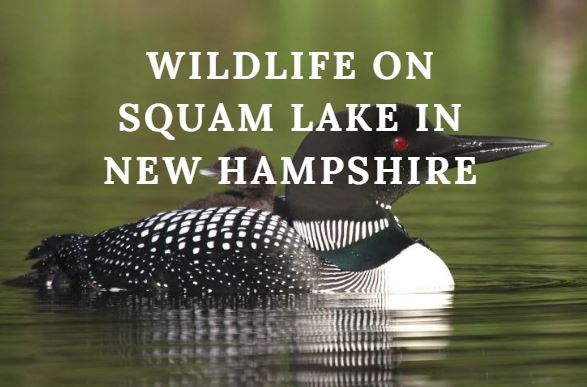
From large mammals to tiny insects, the Squam Lakes and Watershed are home to a diverse array of wildlife. The Squam Lakes Association (SLA) works cooperatively with other state and municipal government, educational institutions, and other organizations to protect wildlife and conserve habitat.
Loons on Squam Lake
text provided by the Loon Preservation Committee

The shores of Squam Lake would not be the same without the haunting calls of the Common Loon. Loons are fishing-eating birds that spend the winter off the New England coast and return to New Hampshire’s lakes soon after ice-out. A single pair of loons defends a portion of a large lake like Squam, and often the same loons return to their territory year after year. Loons nest in late May and normally lay two eggs, which hatch after 28 days. Both parents share incubation and chick-rearing duties, and the chicks are not fully independent until 12 weeks of age.
Concerted efforts to protect this state-threatened species in New Hampshire began in the mid-1970’s on the Squam Lakes and have continued to the present, producing the longest, most complete study of loons in the world. Because of their place at the top of the aquatic food web, loons are sensitive indicators of environmental contamination, and can be severely impacted by changes in shoreline habitat and human lake use. Monitoring and management with artificial nest rafts and nest site barriers help buffer Squam loons from some of these human impacts.
After three decades of protection, recent attention has been focused on a sharp decline in the number of adult loons breeding on Big Squam, with a 44% drop from 16 territorial loon pairs in 2004 to nine pairs in 2005. Although the number of adults has recovered to pre-2004 levels, chick production on the lake remains well below both statewide levels and historical levels on Squam. Research into potential causes for the decline is ongoing, but initial findings suggest that multiple interacting factors contributed to the decline, including: chemical contaminants, increased recreational activity on the lake, increasing temperatures and changing precipitation patterns, and possible disruptions to the food web on Squam.
By being aware of the needs of the loons, people can share the lake with them. Anglers should use non-lead tackle when fishing, as lead fishing tackle is the leading known cause of adult loon mortality both on Squam Lake and throughout New Hampshire. For more information about NH lead tackle regulations, please click here! Boaters should exercise caution and observe these fascinating birds from a safe distance, as canoes, kayaks, and motorboats can all disturb nesting and brooding loons. Please stay at least 150-200 feet away from nest sites and adults with young. For more information on loons and how you can help, please visit www.loon.org or contact the Loon Preservation Committee at (603) 476-LOON. Click here to learn more about the Squam Lake Loon Initiative.
Squam Lake’s Breeding Bald Eagles
text provided by Chris Martin, NH Audubon
In 2003, a pair of bald eagles nested successfully on Squam Lake for the first time since the 1930s or earlier. They successfully raised one young in 2003. Through 2012, Squam Lake’s eagle pair has fledged a total of 18 young, and has been productive in nine of ten breeding seasons during that period.

New Hampshire’s recovering population of bald eagles has been aided by our state’s proximity to other expanding populations in Massachusetts, Maine, New York, and Connecticut. Eagles are long-lived and often occupy the same breeding territory for a decade or more. In 2003, we first identified Squam’s adult male eagle by reading his gold-colored leg band; he was “Gold W86,” raised in the Russ Mountain territory at Quabbin Reservoir in Massachusetts in 1997. In 2010 we finally identified his mate; she was “Gold WA8,” raised on a separate Quabbin Reservoir eagle territory in 1999. Assuming that both this male and female remain alive, they will be 15 and 13 years old, respectively, in 2013.
The SLA has taken a direct role in managing the bald eagle nest site on Squam, specifically in efforts to limit human-related disturbance at the nest. By working with the nest island’s private landowner, summertime landing on the island is prohibited. Working with NH Fish and Game and NH Audubon, and using NH “Moose Plate” funds, volunteers designed, built, and installed a set of durable floating signs that create a visible and much-needed permanent buffer zone around the nesting island.
Bald eagles remain classified as “threatened” in the state of New Hampshire, but have been removed from the federal list of endangered and threatened wildlife. NH Audubon biologists and volunteers, in collaboration with NH Fish and Game, have been monitoring and managing our state’s bald eagle population for more than 25 years.
The 2012 bald eagle breeding season in NH was the best in more than 60 years. Eagle monitors identified 35 territorial pairs, documented 20 productive nests, and confirmed the fledging of 33 young; all these figures represent post-DDT era record-high totals for the Granite State.
2002 Squam Watershed Bioinventory
In 2002, the SLA contracted with Dr. Rick Van de Poll of Sandwich to complete a comprehensive bio-inventory of the watershed. Biodiversity, or biological diversity, encompasses the diversity of genes within species, species within ecosystems and of entire ecosystems. Biodiversity is declining at a rapid pace on a global scale and threatens ecological sustainability. Recognizing the increasing significance of maintaining biodiversity, this biomonitoring project was a proactive step toward the long-term conservation of the Squam Lakes Watershed. A summary of some of the findings can be found in the Species List below. Please contact the SLA for further information.
Squam Species List
View Original Article here. Re-Posted by Scott Freerksen “The Lake Guy”
